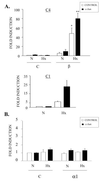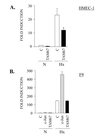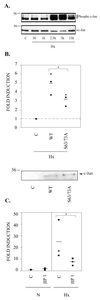c-Jun and hypoxia-inducible factor 1 functionally cooperate in hypoxia-induced gene transcription
- PMID: 11739718
- PMCID: PMC134229
- DOI: 10.1128/MCB.22.1.12-22.2002
c-Jun and hypoxia-inducible factor 1 functionally cooperate in hypoxia-induced gene transcription
Abstract
Under low-oxygen conditions, cells develop an adaptive program that leads to the induction of several genes, which are transcriptionally regulated by hypoxia-inducible factor 1 (HIF-1). On the other hand, there are other factors which modulate the HIF-1-mediated induction of some genes by binding to cis-acting motifs present in their promoters. Here, we show that c-Jun functionally cooperates with HIF-1 transcriptional activity in different cell types. Interestingly, a dominant-negative mutant of c-Jun which lacks its transactivation domain partially inhibits HIF-1-mediated transcription. This cooperative effect is not due to an increase in the nuclear amount of the HIF-1alpha subunit, nor does it require direct binding of c-Jun to DNA. c-Jun and HIF-1alpha are able to associate in vivo but not in vitro, suggesting that this interaction involves the participation of additional proteins and/or a posttranslational modification of these factors. In this context, hypoxia induces phosphorylation of c-Jun at Ser(63) in endothelial cells. This process is involved in its cooperative effect, since specific blockade of the JNK pathway and mutation of c-Jun at Ser(63) and Ser(73) impair its functional cooperation with HIF-1. The functional interplay between c-Jun and HIF-1 provides a novel insight into the regulation of some genes, such as the one for VEGF, which is a key regulator of tumor angiogenesis.
Figures







References
-
- Aragones, J., D. R. Jones, S. Martin, M. A. San Juan, A. Alfranca, F. Vidal, A. Vara, I. Merida, and M. O. Landazuri. 2001. Evidence for the involvement of diacylglycerol kinase in the activation of hypoxia-inducible transcription factor-1 by low oxygen tension. J. Biol. Chem. 276:10548–10555. - PubMed
-
- Bandyopadhyay, R. S., M. Phelan, and D. V. Faller. 1995. Hypoxia induces AP-1-regulated genes and AP-1 transcription factor binding in human endothelial and other cell types. Biochim. Biophys. Acta 1264:72–78. - PubMed
-
- Bannister, A. J., T. Oehler, D. Wilhelm, P. Angel, and T. Kouzarides. 1995. Stimulation of c-Jun activity by CBP: c-Jun residues Ser63/73 are required for CBP induced stimulation in vivo and CBP binding in vitro. Oncogene 11:2509–2514. - PubMed
Publication types
MeSH terms
Substances
LinkOut - more resources
Full Text Sources
Other Literature Sources
Molecular Biology Databases
Research Materials
Miscellaneous
